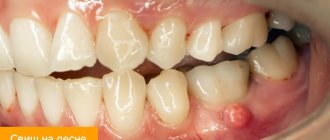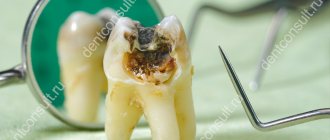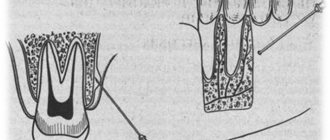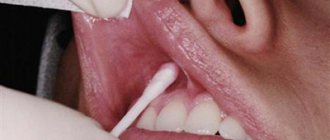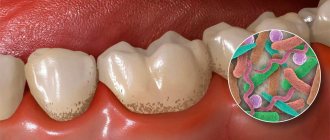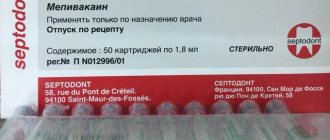- Operating principles
- Anesthesia methods
- Indications and contraindications
- Types of anesthesia
- pain relief in pregnant women
- Anesthesia for children
- Recommendations
- Complications
- Drugs used
- Price
Nowadays, it is possible to receive medical care not only fast and high-quality, but also painless. Almost any action of the doctor that can bring discomfort or unpleasant sensations to the patient is accompanied by dental anesthesia, or in other words, “freezing”. He stops experiencing pain and fear and relaxes, allowing the dentist to calmly do his job.
Operating principles
Anesthesia is carried out immediately before the start of treatment. The anesthetic comes in both liquid and gel form. The doctor injects into the soft tissues that are located near the diseased tooth. After some time, the tongue, gums and cheeks become numb and “freeze”. At this moment, the anesthetic acts as a blocker of nerve impulses that send a pain signal to the brain. The patient calmly endures dental procedures without experiencing stress.
The duration and effectiveness of dental anesthesia depends on the quality of the materials used and the location of the injection. The closer to the problem area the injection was administered, the more intense its effect. Each organism is individual, therefore the drug will be excreted at different rates.
Different types of drugs function in their own ways. For example, gel-like ones applied to the gums or surface of the cheek last only a couple of minutes. If they are installed in the upper part of the jaw, the effect will last for 2-3 hours. To treat the lower group of teeth, a deeper injection is required, so the result lasts up to 4 hours. After the solution is absorbed, the numbness disappears and sensitivity returns to the patient.
The main causes of pain after injection into the gums
The main cause of pain after an injection is damage to the gums by the needle. Pain appears when the action of the analgesic subsides. Normally, the patient is in pain for 2-3 days, and after surgery (more damage - several injections) up to 14-15 days.
If the pain does not subside, but on the contrary, it begins to hurt more severely, you need to consult a doctor again. Such manifestations indicate the presence of acute inflammation, edema, infection or manifestations of postoperative complications (cyst, abscess).
Possible causes of prolonged pain after surgery may be: injuries during surgery; inadequate analgesia (without calculating how long an anesthetic injection lasts or the wrong combination of drugs).
Nerve trunk injury
Damage to the nerve trunk often occurs during conduction or trunk anesthesia, when the anesthetic enters the nerve fiber and kills some of the cells. Due to the death of brainstem neurons, the sensitivity of the innervated area decreases. Restoration of receptor function will occur without medical assistance.
Formation of hematoma on the gum
Since the gums are well supplied with blood, there is a high risk of hematoma formation during injections. Damage to small capillaries will not lead to the formation of large hematomas. But if you give an injection and get the syringe needle into a vessel of a larger diameter, the released blood will accumulate in the gum faster and to a greater extent. This forms a hematoma, causing discomfort and pain to the patient.
If a large hematoma is detected in the oral cavity, it is necessary to consult a dentist in order to reduce the risks of possible complications.
Allergy to anesthetic
Before the injection, doctors ask patients about the presence of allergic reactions to any drugs and review the patient’s medical record for allergies.
Considering these data, the medical specialist begins to administer anesthesia. An allergic reaction occurs instantly at the time of drug administration and is characterized by an increase in the characteristic clinical picture:
- the mucous membrane of the oral cavity swells;
- cheek swells;
- shortness of breath occurs;
- general excitement of the patient appears.
Therapeutic measures to eliminate allergies are carried out by a doctor in the dental chair: antihistamines and decongestants are administered, and the administration of the anesthetic or antibiotic that led to the body’s allergic response is stopped.
Necrotization of soft tissues
If anesthesia is inadequate (injection of a large amount of anesthetic) or an allergic reaction occurs at the time of drug administration, a complication such as necrosis of gum tissue may occur.
The necrotic area of the gum is dead cells that are no longer able to recover. If such a tissue area is insignificant, then the damaged area will be restored by neighboring healthy cells, while with large necrosis, scar formation occurs (replacement of cells with connective tissue).
Another cause of necrosis can be infection in the gum tissue and its rapid progression. If the next day a white spot appears at the injection site, surrounded by an inflammatory cushion, and the patient self-medicates without consulting a doctor again, irreversible tissue death may occur.
Clinical picture of gum necrosis:
- the appearance of plaque or blackening of the gums;
- formation of ulcers;
- bad breath;
- soreness around the lesion;
- increased body temperature;
- general malaise and chills.
Development of an infectious focus
Infection during medical procedures is possible due to poor sterilization of instruments or as a complication of improper postoperative care for the patient.
Contamination of the wound at the injection site causes a local response from the immune system - the formation of an inflammatory zone around the site. If you ignore the growing clinical picture or self-medicate, intoxication syndrome appears (febrile temperature, weakness, loss of appetite).
Treatment in a dental clinic will be aimed at eliminating the causative agent of infection (antibiotic therapy) together with the use of antihistamines and anti-inflammatory drugs.
Anesthesia methods
Depending on the goals and nature of the problem, the doctor chooses the method of pain relief. In medicine there are two main methods:
Anesthesia
It is most often used in surgery, and in dentistry much less often, in case of urgent need. It affects the entire body of the patient, inducing a state of sleep. At this time, all muscles relax and consciousness turns off. You can administer painkillers intravenously or inhale vapors through a mask. Deep anesthesia is used during complex operations when a person does not have enough strength to cope with pain or it is necessary to completely eliminate body movement. During sleep, the doctor monitors the patient's condition to avoid emergency situations.
Recovery from anesthesia is the body’s return to normal functioning after a long “freeze.” For all people, this process proceeds differently, some experience signs of nausea or a feeling of lethargy, while others wake up well-slept and rested.
General anesthesia in dentistry during pregnancy is applicable only in emergency cases when there is no other alternative.
Local anesthesia
Unlike anesthesia, it occurs locally, affecting only certain areas of the body. Can be used for children and pregnant women, without fear of unwanted consequences. In dental practice, this method is most often used, so we will talk about it in more detail.
Is it painful to treat caries on the front teeth?
Due to their location and structural features, caries on the front teeth is more difficult to treat. If the damage is severe, it is not always possible to put a filling, and then you will have to resort to prosthetics.
There are other features:
- The front teeth, compared to molars and premolars, have thinner and more sensitive enamel. It is easily destroyed, opening access to sensitive dentin, so the central incisors are more sensitive to pain.
- The front teeth, which are used for gripping and cutting food, are subject to high stress and wear out more quickly.
- A large cavity is often hidden under a small chalk point. And often caries is detected already at the stage when it is difficult to cure without pain. Therefore, in most cases, anesthesia is used in the treatment of caries of central incisors.
- Increased aesthetic demands are placed on the front teeth, so the filling must be placed not only reliably, but also beautifully.
That is why the condition of the front incisors - teeth with a small chewing surface area - must be monitored especially carefully.
If caries affects the front teeth, due to the thin enamel and dentin, it very quickly passes into the middle and deep stage, affecting the sensitive pulp. If you do not know whether it is painful to treat deep caries of the front teeth and doubt whether you need anesthesia, we recommend that you definitely agree to an anesthetic injection. Of course, in the absence of contraindications to the anesthetic. Because treating caries on the front teeth is painful.
Indications and contraindications for the use of local anesthesia
Any dental intervention that causes pain must be accompanied by “freezing” of the required area of the oral cavity. There is a list of diseases for the treatment of which it is necessary to administer anesthetic drugs:
- Complex caries;
- Removal of a tooth or its roots;
- Periodontitis;
- Inflammatory processes in the dental system;
- During prosthetics.
Before drawing up a treatment plan and choosing medications, the doctor must interview the patient and find out from him the presence of contraindications in order to exclude the possibility of complications.
- Allergy to drugs used;
- Heart diseases;
- Diabetes;
- Problems with the endocrine system.
Does it hurt to give an injection in the gum?
The painful process of needle penetration into the gum is insignificant, since dentists use small-diameter needles, damaging a small area of tissue of the oral mucosa.
Whether it hurts to give an injection in the gum is a question of the patient’s psychological state and his mood for treatment. Before performing the puncture, the doctor reassures the patient, reminding him that the injection is painless, since this manipulation is short-lived.
If the patient refuses anesthesia, the dentist warns about the increased likelihood of unbearable pain during surgical interventions, and any movements in the dental chair can lead to errors in treatment or complete ineffectiveness of the treatment measures taken.
People who have a high threshold for pain sensitivity are recommended to use anesthetic gels and sedatives (glycine, valerian, etc.) before going to the dental clinic (or before an injection while in line to see a doctor).
Types of anesthesia
There are several methods in medicine; they differ in duration, effectiveness and location.
Conductor.
The most common type of local anesthesia in dentistry. Using a special needle, the drug is injected near the nerve trunk, blocking pain impulses that go to the brain. The injection is given in doses not exceeding a volume of 5 ml. To ensure a guaranteed result, the injection is placed at an angle of 90 degrees.
“Freezing” applies only to a certain group of teeth, in the place where the treatment will take place. After about 15 minutes, the medicine begins to work and the doctor can begin work.
The injection site can be additionally lubricated with lidocaine. If during the procedure the patient continues to feel discomfort, another dose may be administered.
Infiltration
It differs from the conductor only in the angle of the needle and the place of application. The drug is injected directly into the root apex area. This type is most effective for teeth and upper jaw. With infiltration anesthesia, you can “freeze” both a small area and a large surface of the oral cavity along with soft tissues.
Applique
This method is performed without a syringe. The dentist applies the necessary product directly to the diseased tooth and the soft tissues surrounding it using a cotton swab or fingers. Some doctors spray anesthetics using a special spray.
It is mainly used during simple and quick operations, since its effect is short-term and does not protect against severe pain. The result is stored for a maximum of 20 minutes. It is often used as the first stage before the injection “freezing” method.
Intraosseous
The dentist resorts to this technique much less often when other types of anesthesia have proven ineffective. An analgesic that is injected directly into the hard tissues between the teeth. The difficulty lies in the technique; to get to the bone, the doctor cuts the gum and drills a hole in it with a bur. This is the most effective method for quickly and permanently freezing the required area.
Intraligamentary
Its peculiarity is the high speed of injection, so numbness occurs almost immediately, but lasts only 20-30 minutes. The advantage of intraligamentary anesthesia in dentistry is that it acts directly on the tooth without touching the cheeks, lips and tongue. That is why the recovery process is much easier.
Procedure and types of anesthesia
The dose of the anesthetic drug is selected depending on the type of upcoming intervention and the condition of the individual patient. If a small carious lesion is to be treated, a specialist can use lidocaine in the form of a 2% spray. It is enough to simply spray the gums with this product or stick a special analgesic strip on the gums, for example, Kalgel or Dentinox.
Also, after a small local anesthesia, the dentist can inject an anesthetic into the already slightly numb gum tissue using a syringe. The injection site should be located as close as possible to the diseased tooth, this will reduce the risk of developing gingivitis or periodontitis due to injury to healthy tissue in the future. In dentistry, it is customary to distinguish several types of effects of local anesthesia.
Anesthesia for a large area of tissue damage (carried out only in a hospital setting and under the supervision of an anesthesiologist), anesthesia for implantation or extraction of teeth (involves injection of the drug into the bone cavity), anesthesia during the treatment of painters (injected into the cheek), conduction anesthesia (aimed at stopping pain in nerve endings when it is necessary to treat several adjacent teeth at once), infiltration anesthesia (for the treatment of caries).
previous post
Is it possible to treat a tooth at home?
next entry
Features of pain relief in pregnant women
One of the most common misconceptions is that pregnant women are contraindicated for dental treatment. You should not trust unreliable sources; dentistry and pregnancy are completely compatible concepts. Expectant mothers should undergo a professional examination during planning and at 8, 18 and 28 weeks of pregnancy. Untreated infections in the oral cavity contribute to the development of other dangerous diseases.
The question immediately arises: can the use of dental anesthesia harm the health of the unborn child? Modern technologies allow the use of drugs with lower concentrations of adrenaline. Accepted painkillers are ultracaine, primacaine or mepivacaine*. They do not penetrate the placenta, therefore, do not harm the body of a pregnant woman.
*A verified and accurate list of acceptable medications can be obtained from your doctor.
Anesthesia for children
Painless pediatric dentistry is a hot topic today. All parents know what a trip to the dentist means for a child. If this brings few pleasant emotions to an adult, then what can we say about children. The first scheduled visit is always scheduled for the age of 6-7 years - this is the time when baby teeth are replaced with permanent ones.
The psyche of children is not yet fully formed; one wrong word or action can provoke the development of unpleasant memories. Therefore, it is important to instill confidence in the child, to mentally prepare him for the procedure: explain why he is going there and what the doctor will do. The use of anesthetic agents in pediatric dentistry is an integral part of comfortable treatment.
The most suitable injection methods for babies are infiltration, conduction and application. The place where the drug is administered is “frozen” in advance and only then does the doctor give an injection. The child’s body is not yet fully formed, so in pediatric anesthesia, special medications are used that make it possible to carry out the procedure safely.
Is caries treatment painful?
Many people are convinced that caries is painful to treat, and therefore are afraid to go to the dentist. The problem goes back to the recent past, when anesthetics were not used in dentistry. Just a few decades ago, no one could even imagine that it was possible to treat teeth with anesthesia, and all manipulations were performed “live.”
In this article
- Is caries treatment painful?
- Is it painful to treat dental caries with anesthesia?
- Is anesthesia always necessary?
- How to treat caries with an injection step by step?
- Is it painful to treat caries on the front teeth?
- What anesthesia is used in the treatment of caries?
- Who is contraindicated for anesthesia?
- Conclusion
Of course, with this approach it was very painful to treat deep caries and other stages of this disease that affected the sensitive parts of the tooth. Fortunately, dental treatment methods have changed, modern safe anesthetics have appeared, and it has become easier to treat with an injection.
Recommendations
For the successful use of anesthetics, there are two conditions: 1) the patient must abstain from drinking alcohol at least 24 hours before treatment; 2) feel good.
Often, after the effect of painkillers wears off, the patient experiences pain, swelling, tingling at the injection site, and difficulty opening the mouth (trismus). Within 2-4 days, all residual effects should disappear.
After treatment, sensitivity returns gradually, so take the food carefully so as not to accidentally bite yourself. It is also recommended to quit smoking during this time.

